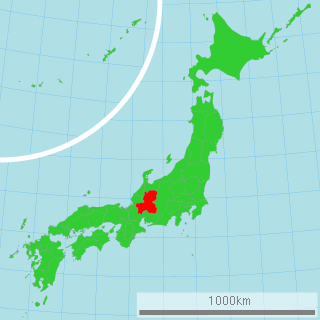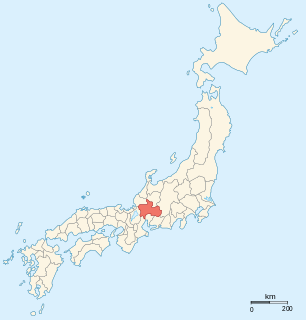
Seki is a city located in Gifu, Japan. As of 1 January 2019, the city had an estimated population of 89,020 and a population density of 190 persons per km2 in 35,366 households.. The total area of the city was 472.33 square kilometres (182.37 sq mi).

Mizuho is a city located in Gifu, Japan. As of 30 November 2018, the city had an estimated population of 54,686 and a population density of 1900 persons per km2, in 20866 households. The total area of the city was 28.19 square kilometres (10.88 sq mi).

Ōno is a city located in Fukui Prefecture, Japan. As of 1 July 2018, the city had an estimated population of 33,640 in 11,747 households and the population density of 39 persons per km². The total area of the city was 872.43 square kilometres (336.85 sq mi). The town is encircled by a ring of mountains and the only way in or out is via tunnels or mountain roads.

Gero is a city located in Gifu, Japan. As of 31 October 2017, the city had an estimated population of 33,283, and a population density of 39 persons per km2, in 12,253 households. The total area of the city was 851.21 square kilometres (328.65 sq mi). The city is famous for its hot springs.
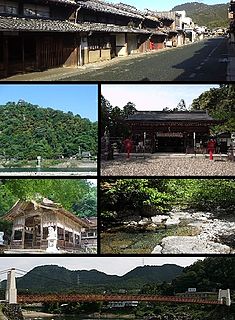
Mino is a city located in Gifu, Japan. As of 31 December 2018, the city had an estimated population of 20,749 in 8149 households, and a population density of 180 persons per km2. The total area of the city was 117.01 square kilometres (45.18 sq mi). The city is renowned for traditional Japanese Mino washi paper and its streets, which are in the style of the early Edo period (1603–1868). An urban area known as "Udatsu Townscape" (うだつのあがるまちなみ) is designated as an important traditional building group conservation area by the government on May 13, 1999.

Hakusan National Park is a national park in the Chūbu region of Honshū, Japan. Established in 1962, it spans the borders of Fukui, Gifu, Ishikawa, and Toyama prefectures. Its main geographical feature is Mount Haku. In 1980 an area of 480 km² corresponding to the national park was designated a UNESCO Man and the Biosphere Reserve.

National Route 472 is a highway between Imizu, Toyama Prefecture and Gujo, Gifu Prefecture in Japan.

The Nagara River has its source in the city of Gujō, Gifu Prefecture, and its mouth in the city of Kuwana, Mie Prefecture, Japan. Along with the Kiso River and Ibi River, the Nagara River is one of the Kiso Three Rivers of the Nōbi Plain. Previously, the river was named Sunomata River. With a length of 166 km (103 mi), it drains an area of 1,985 square kilometres (766 sq mi) in the Chūbu region and empties into Ise Bay. The government of Japan classifies it as a Class 1 river.
The Hirugano Botanical Garden is a botanical garden located in the skiing region near Mount Dainichi in the Takasu area of the city of Gujō, Gifu Prefecture, Japan.

Gujō Hachiman Castle is a yamashiro, or mountain castle, located on Hachiman Mountain in Gujō, Gifu Prefecture, Japan.

Takasu was a village located in Gujō District, Gifu Prefecture, Japan.
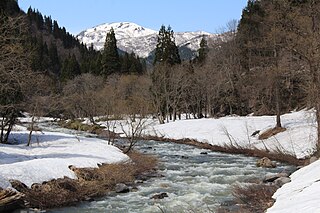
The Itoshiro River is a river through Gifu and Fukui prefectures in Japan.

Chūnō (中濃) is the central portion of Gifu Prefecture in the Chūbu region of Japan. Before Gifu became a prefecture, the area was part of Mino Province. The Chūnō region received its name as a combination of the kanji for "middle" (中) and "Mino" (美濃). The borders of this region are not officially set, but it generally consists of thirteen municipalities. There are five cities in addition to the towns and village in the Kamo and Kani (Mitake) districts also fall into the Chūnō region. Occasionally, Gujō is separated from the Chūnō region and is said to be part of the Hokunō region.

Mt. Bessan is located on the border of Gujō, Gifu Prefecture, and Hakusan, Ishikawa Prefecture, Japan, and rises to a height of 2,399 m (7,871 ft). There are two triangulation stations at the top of the mountain. Mount Haku can be seen from the north. Bessan Shrine is a short distance from the peak. This area is part of Hakusan National Park.(Note: there is a second Mt. Bessan in located in Toyama Prefecture.)

Mt. Sannomine is located on the border of Gujō, Gifu Prefecture, and Hakusan, Ishikawa Prefecture, Japan, and rises to a height of 2,128 m (6,982 ft).
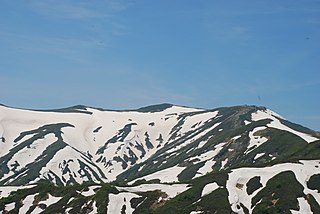
Mount Iide is the main peak of the Iide mountain range that spans the Fukushima, Niigata and Yamagata prefectures in Japan. On top of the mountain stands the Mount Iide Shrine (飯豊山神社). Mount Iide is, together with the rest of the range, one of the mountains described in Kyūya Fukada's book 100 Famous Japanese Mountains.



